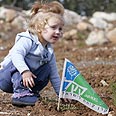
Planting trees on Tu B'Shvat
צילם: קק"ל, יעל אילן
Tu B'Shvat is here
It actually came to life for tax reasons, but it became the holiday of trees and nature. Introducing Tu B'Shvat…
The tradition of eating fruits – fresh and dried – is not part of the initial origins of Tu B'Shvat. When our sages set the 15th day of the Hebrew month of Shvat as the New Year’s Eve for the tree, they had no intention of creating a holiday.
Originally, Tu B'Shvat marked the end of the fiscal year. In those days, Tu B'Shvat was the date for allocating donations and tithes – in other words, tax day in an agricultural society. But frankly, who turns a tax day into a holiday? And how did the day turn into a holiday of planting trees and eating fruits?
The origins of the festivities lie in the title given to this day in the Mishnah (Rosh Hashana, 1:1) "Rosh Hashana for trees." The use of the words "Rosh Hashana" and the tree (“Ilan”) turned into a great opportunity to merge nature with the land of Israel. And so the "blooming" of Tu B'Shvat, this most Israeli of holidays, was actually created in the Diaspora, at a time when the people of Israel were separated from Israel.
This was not because of Jewish law, but quite the opposite. Jewish law dictates right and wrong, without regard for emotion. However, the traditions of Tu B'Shvat grew out of emotions that were interlaced with nature. The people of Israel, exiled from their country, distant from their land, stripped and uprooted from their property, sought their roots.
In an effort to connect with the Land of Israel, the Tu B'Shvat tree was the most appropriate symbol. Its many qualities and its essence expressed the roots which were lacking.
Dreaming of Israel
So how do you export a holiday that is all Israeli to a house surrounded by snow in Lithuania or Warsaw, Frankfurt or Kiev? You pretend. You take a plate, pile it high with dried fruit – a dry carob and a shrunken date – that grow in Israel (or maybe Turkey), and you dream.
You fantasize that you are in Israel, a country where dreams are fulfilled, but until that moment you will feel, smell and taste all of it in "make-believe." And you would end by saying: “Let us be fortunate enough to reach Israel, eat its fruit and be satisfied by its goodness”.
The greatest change in Tu B'Shvat’s nature took place in the 17th century with the publication of the mystical work "Hemdat Yamim." The book includes a chapter dedicated entirely to the eve of Tu B'Shvat, with instructions for a sort of Pesach seder meal, including eating 30 types of fruit, drinking 4 cups of wine, and reading sections on Israel’s fruits from the Torah, both oral and written, and the mystical Zohar.
The fruits are traditionally divided into three groups and the wine in different colors. The three fruit groups - whose fruits were peeled and their insides eaten (orange, grapefruit and banana) – represent the world of doing.
The world of production is represented by fruits whose skin is eaten and the rest tossed (prunes, peaches), and the world of creation is represented by fruits eaten whole (strawberry, fig).
The first cup of wine is completely white – a sign of winter, and the last cup completely red – a sign of the hot summer ahead. The middle two cups – one mostly red with some white – represents spring, and one mostly red with some white is a symbol for autumn.
The so-called Tu B'Shvat Seder was very popular amongst Jewish communities in the Diaspora, and with the dawn of the Zionist movement the custom made its way to Israel,
And so Tu B'Shvat became integrated with the immigrant movement. There was no need for a reminder – this was the real thing, life in Israel. So, a new tradition became necessary, and the Rosh Hashana for trees became the holiday of planting trees.
The first trees were planted in Yesod Hamala, and in 1890 the tradition was formalized by educator and historian Zeev Yabetz, school principal at Zichron Yaakov. In 1908, the Jewish National Fund board of teachers decided to make Tu B'Shvat the holiday of planting trees.
Over the years, tree planting has dwindled and the tradition of Tu B'Shvat seder has reappeared. More than two million Tu B'Shvat Haggadahs that I edited were distributed by the Education Ministry to every home in Israel. Have a happy holiday.
Yoel Rafel will conduct a Tu B'Shvat seder at Beth Hatefutsoth, the Nahum Goldmann Museum of the Jewish Diaspora, in Tel Aviv, Monday at 5 p.m. Shelley Goldberg, PhD, a Kabbala researcher from Bar-Ilan University and singer Ora Zitner will also participate










